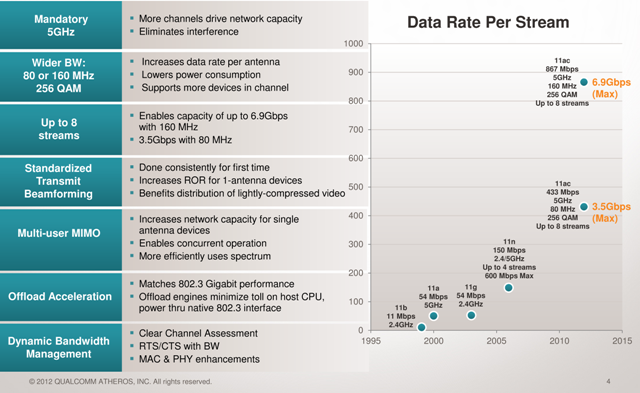During CES I noted a lot of brands were releasing products that were quite amazing on an individual level, but that look like they were meant to compete with products that Apple has already released. There were tablets, ultrabooks, smart TVs; even the HP Envy Spectre, which looks eerily similar to a MacBook Pro. While these brands have continued to raise the bar for electronics in a fiercely competitive industry, they are forgetting, in my opinion, the ecosystem that sets companies like Apple and Sony apart from the rest. Qualcomm Atheros has seen this trend and they are preparing a blueprint for the future of wireless communications that will enable mobile and electronics developers to create their own wireless ecosystem in their product schemes.
The 802.11ac standard certainly opens the door for a whole new array of wireless capabilities on everything from mobile devices to the enterprise. Here is a look at some of the features of 802.11ac:
As you can see, with increased bandwidth, more channels, as well as the introduction of Mutli-User MIMO, 802.11ac has a lot of room to grow It also has the potential to serve more clients, with more demanding requirements. In 2015 it is estimated that the number of devices connected to IP networks will be double the world’s population. Wireless technology is already very simple and easy to implement in the home or a small office. Naturally, the proliferation of wireless devices is expected to grow at a much higher rate than wired network devices over the life of the 802.11ac standard.
Practical Gigabit wireless
Qualcomm, instead of focusing on maximizing the constraints of 802.11ac technology out of the gate, has planned a roadmap for a wireless ecosystem that is secure, stable and will deliver speeds capable of handling our ever-increasing bandwidth needs. They aim to provide a “practical” gigabit wireless performance spectrum that will meet increasing demands.
Two of the constraints we have now with 802.11n are the increasing speeds of accessible internet connections—currently 105 Mbps connections are available to the home here in Detroit—as well as the increased demand for high-quality streaming content, which most people have already seen the constraints of while trying to stream HD content through Netflix on a wireless connection.
Qualcomm’s value proposition is to provide an ecosystem of technologies that will enable seamless wireless transfers of data, with lower latency, extended range, higher bandwidth, less power consumption and efficient multi-threading.
For mobile devices, a single-channel 802.11ac chip will deliver speeds of up to 433 Mbps, or around 300 Mpbs effectively. These chips will also have optimizations that will enhance their performance and efficiency as they are paired with the 28nm Qualcomm Snapdragon SoC. Higher bandwidth and faster speeds means your mobile device will finish downloading data quicker, leaving more time for the processor to go into low-power or sleep mode, effectively increasing battery life.
Networking products will be divided into two categories. The mainstream line of 802.11ac SoCs will use a dual-channel interface. This is what you will find in a typical $100 home router. With an 80 Mhz bandwidth, 256 QAM and dual-channel MIMO, these devices will see speeds up to 867 Mbps. The SoC architecture maintains an Ethernet-like load on the system, freeing up more resources for the host processor. The Premium line of 802.11ac wireless NPUs will be available for high-end wireless networking systems. These devices will use an 80 Mhz bandwidth, 256 QAM and triple-channel MIMO for speeds up to 1.3 Gbps.
Multi-User MIMO
In the past, wireless communications have been fair and balanced, similar to the token ring concept we may remember from the olden days. Bandwidth streams are split between each connected device so that each device is given an equal piece of the bandwidth pie. With Multi-User MIMO, wireless devices will take advantage of dual and triple channel networking devices by using a multi-in multi-out threading scheme that allows the network device to communicate with more than one client at a time, for more efficient use of the wireless spectrum. This will enable the end-user to attach more devices, as well as be able to handle large bandwidths to those devices concurrently. Multi-User MIMO is expected in the first half of 2014.
Building the Ecosystem
The array of Qualcomm Atheros solutions available will spell out a roadmap for continued growth and integration of an entire Ecosystem of available products. For example, a company that would like to offer an ecosystem of wireless devices, similar to the Apple ecosystem, could present an entire cadre of wireless devices using Qualcomm Atheros chips designed to make them communicate faster, and lowering the cost of manufacturing.
Smartphones, smart TVs, tablets and mobile gaming devices powered by Snapdragon and paired with an 802.11ac mobile chip will achieve this goal by optimizing the load placed on the host processor and networking chip, as well as lowering the bill of materials needed to manufacture the device. Desktop computers and notebooks fitted with the 802.11ac SoC will be capable of speeds up to 1.3 Gbps while lowering power consumption, as well as lowering the cost of manufacturing as well. Wireless Routers and APs, fitted with the 802.11ac Mainstream SoC or Premium NPU will enable all these devices to communicate together optimally.
Conclusion
You can lead a horse to water, but you cannot make it drink. Qualcomm’s progress in electronics and wireless technology has given the industry the tools it needs to change the face of the electronics industry, as well as set a new tone for future CES events. Some companies are likely to use Qualcomm Atheros products in a way they weren’t intended, while others may take advantage of the dependable roadmap that has already been laid out. This will further cohere their status as a robust, prudent, heterogeneous technology developer.







 Articles RSS
Articles RSS